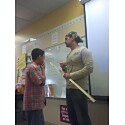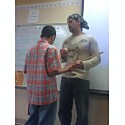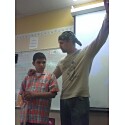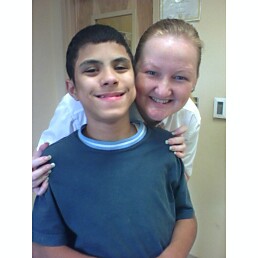
Georges Bizet
1838 - 1875
Georges Alexandre César Léopold Bizet was born on 25 October, 1838 in Paris. His mother was a pianist, and his father taught voice and composed. It seems likely that Bizet was probably as musically precocious as Felix Mendelssohn or Wolfgang Amadeus Mozart.
It is said that he could read and write music by the age of four, and with a very encouraging family, his parents actually hid books from him to suppress his literary bent and encourage more diligent applications to music, Bizet's future in music was pre-ordained.
Bizet entered the Paris Conservatoire de Musique in 1848, at the age of nine, and studied:
piano under Marmontel,
harmony under Zimmerman,
organ with Benoist and
composition with Halevy and
composition with Charles Gounod until the age of twenty.
H is years there were punctuated by a series of prizes for theory, piano, organ and composition. In 1855, at the age of seventeen, he composed his lovely Symphony in C. This piece was not performed until 1935 because Bizet was afraid that he would be charged with imitation, it was that strongly influenced by his teacher Charles Gounod. In fact, on careful listening, this piece recalls:
Ludwig Van Beethoven,
Joseph Haydn,
Felix Mendelssohn,
Robert Schumann,
Franz Schubert,
Wolgang Amadeus Mozart as well as
Charles Gounod's Symphony in D.
A lthough Bizet chose not to have this Symphony performed, he did later quote it in 'Les Pêcheurs de perles' and 'La jolie fille de Perth'.
Bizet was a Parisian at a time when Paris was a world centre of opera, boasting some of the
best-equipped opera houses and theatres, including the Paris Opéra. Nearly every 19th-century composer of opera, from Wagner to Verdi, wanted to have his works staged there.
For French composers, writing opera was the one sure way to musical fame and fortune. Like all French composers of his time, Bizet desperately wanted to write successful operas. Bizet did win the coveted Prix de Rome for composition in 1857 with the premiere of his sparkling operetta 'Le Docteur Miracle', and the 1867 Premiere of his opera 'La jolie fille de Perth', was also favorably received by press. But from then on, his career was followed by bad luck, which pursued him to the grave.
His personal life, too, was plagued by bad luck. In 1860, Georges returned to Paris but refused all offers of teaching and a career as a concert pianist. Instead, he dedicated himself to composition. Early into his return to Paris, Georges' mother died.
Georges consoled himself with his parents' house cleaner, with whom he had a son in 1862. The Opera-Comique was rehearsing his one-act 'La guzla de l'emir', which was eventually withdrawn when the Theatre-Lyrique director invited Bizet to compose Les pecheurs de perles (The Pearl Fishers). Bizet finished the opera in four months and it was produced in September 1863, but received an indifferent reception.
Although the staging was a bit stiff, none could deny Bizet's brilliant scoring, especially in the famous duet, Au fond du temple saint.
In 1865, Georges had a chance meeting on a train from Paris en route to the little village of Le Vesinet with a woman who may have been some of the inspiration for Carmen. Celeste Venard (nicknamed La Mogador) was quite a colorful character whose occupations included prostitution, dance hall escort,
writer, stage director and equestrian to name a few.
Celeste had purchased a home near Bizet's and on that fateful train ride; the two discovered they would be neighbors.
At Bizet's suggestion, Celeste bought a piano and gave him the key to her home so he could compose in peace. In Celeste's memoirs, she insists that the relationship was purely platonic and there is no evidence to suggest otherwise.
Celeste was now singing for her living in a cafe' and performed Ay Chiquita by a composer named Sebastian Yradier, composer of the well-known song 'La Paloma'. Apparently, Bizet liked Yradier's music as he borrowed a theme from Yradier's El Arregilito for the Habanera. Celeste and Georges' relationship ended abruptly, perhaps because of the displeasure of his future in-laws, the Halevys.
I n 1869, Georges married Genevieve Halevy , the mentally unstable daughter of his former teacher. Together they had a son who later committed suicide. Their son, Jacques, was born in 1872. The marriage did not bring much happiness to Bizet.
George Bizet was consistently racked by self-doubt and depression, and it was his refusal to give in to his natural inclination to compose from the 'heart', that caused so many of his compositions to be aborted before completion.
During this time, Bizet continued to compose with some of his works being met with modest success, including his incidental music for Alphonse Daudet's play L'Arlesienne.
T he Bizet's were poor and Georges had health problems and began battling with depression.
He also worked on a one-act opera Djamileh that was completed in 1872. That opera met with little success but Bizet was finally convinced he had found his true operatic path. Djamileh did have one success and that was its impression on director Camille du Locle, the co-director of the Opera-Comique.
He commissioned Bizet and librettists Henri Meilhac and Ludovic Halevy (his wife's cousin) to write Carmen.
The actual story of Carmen was taken from the 1846 Prosper Merimee novel of the same name. In Merimee's novel, Carmen is a rather brutal character without warmth or depth; a gypsy with a common-law husband (a Rom) who Don Jose kills and eventually replaces.
The novel is told from Don Jose's perspective (he is the narrator) and the reader sees his decline from honorable soldier to deserter, smuggler, and murderer. Micaela and Escamillo are rarely mentioned in the novel but Bizet and his librettists fleshed out their characters to balance the overpowering Carmen and Don Jose.
The somewhat comical Dancairo and Remendado are classic Opera-Comique characters.
George Bizet and his librettists began work in 1873 though problems began from the outset with outrage from Adolph de Leuven the Opera-Comique's other director.
The Opera-Comique was a family theater where marriages were arranged, business was conducted and de Leuven felt it was an inappropriate story with its blatant sexuality and frank depiction of gypsy life.
Bizet's librettists also sided with de Leuven and felt that material (as originally written) was too strong and they feared public outrage. A battle followed with de Leuven and the librettists on one side and Bizet, du Locle and the principal singers Paul Lherie (Don Jose) and Celestine Galli-Marie (Carmen) on the other.
Du Locle, being a practical man, did want the ending changed to accommodate the family atmosphere. Lherie and Galli-Marie threatened to quit so du Locle backed down. Bizet, unhappy with the librettist's version of the Habanera, re-wrote the lyrics thirteen times before he was satisfied.
T he original version (with spoken dialogue) premiered on March 3, 1875 and met with a lukewarm response from the audience. Though not a failure (it ran for 45 more performances), Bizet felt that no one understood his work.
Other musicians, however, recognized Bizet's brilliance with praise from
Camille Saint-Saëns,
Peter Tchaikovsky,
Richard Strauss,
Johannes Brahms,
Charles Gounod,
Claude Debussy,
Edvard Grieg,
Giacomo Puccini,
Frederick Nietzsche ('a perfect antidote to Wagnerian neurosis') and
Richard Wagner ('at last some one with new ideas.')
A fter a succession of failures, Bizet pinned all his hopes on Carmen, what was to be his last opera. At its premiere in Paris on 3 March, 1875, many in the audience were shocked by its stark realism: Carmen and her co-workers from a cigarette factory smoking on stage and the sordid stabbing at the end.
The sheer dramatic power of the music also proved a little too much for those who had come to the theatre simply to be entertained. Today, Carmen is regarded as among the finest examples of 19th-century Romantic music written for the theatre, but Bizet never knew of its grand success. His health and spirit shattered by the critical reception of his Carmen, Bizet retreated to the family home at Bougival.
G eorges Bizet died on 3 June 1875, at the age of thirty-seven. On his death, Carmen became a huge success, and Bizet was hailed as a master. Although chiefly known for his Carmen, he was also as inspired a melodist as Schubert was and knew exactly how to spice a tune with pungent harmonies, catchy rhythms, and instrumental colors.
Many have speculated that his premature death was due to his despondence over the perceived failure of Carmen. While this depression probably did not improve his already failing health, Bizet had long suffered from throat problems and the official medical cause of death was a failed heart due to 'acute articular rheumatism'.
It is unfortunate that Bizet did not live long enough to see Tchaikovsky's prediction that Carmen would become 'the most popular opera in the repertory' come true. Carmen has indeed fulfilled the prediction
and more with its commercial success in Hollywood with the movie version Carmen Jones featuring Dorothy Dandridge and Harry Belafonte as well as becoming the score for The Bad News Bears and hundreds of commercials.
The melodies in the Habanera, Seguidilla and the Toreador Song are pervasive, exotic and unforgettable and even 125 years after its premiere, Carmen still captivates audiences and is one of the most produced operas in the world.
His incidental music to Daudet's play "L'Arlesienne" met with approval, and it is now frequently heard as a suite at orchestral concerts. His music possesses great melodic charm, and Bizet had tremendous skill in producing "local color". "Carmen" is full of it, and the whole score is impregnated with the warm glow of the South. He was greatly given to experimenting with his orchestra, and orchestral students with great profit may examine his works.
A fter his death, Bizet's music suffered irreparable damage from his publisher's attempts to cash in on Carmen's success. Unauthorized versions of the music appeared, butchered and altered with new texts and titles, mis-representing the composer's intentions.
Nor can this situation ever be fully rectified, as many of the original autograph manuscripts are now lost. Bizet's struggle for recognition, it seems, continues.
A list of Bizet's works
















































kenny you will shine no matter were you are in life. you have lifted your heart and opened the doors for the world to see how specail you are. life will give what you will give your self. I have always enjoyed how your teacher Mr Stuart teaches you and your class. and i know he is very proud of you and your class mates
-JD
I MISS KENNY (X>X)!!! from Skyler Martin
Kenny is Back!!!